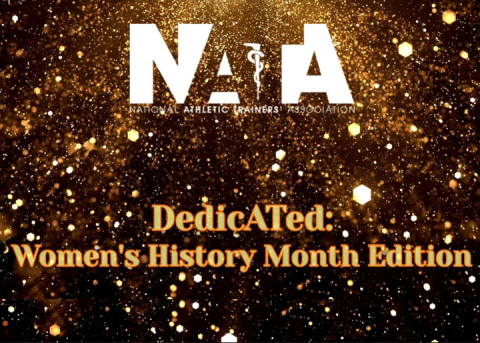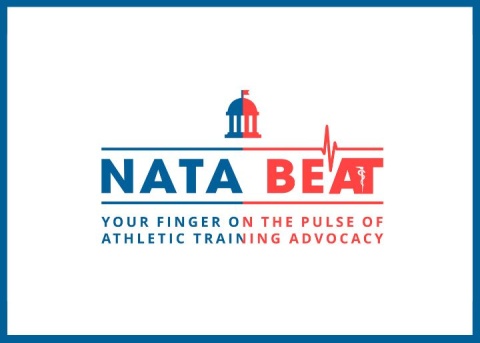
In honor of Women’s History Month this March, NATA is highlighting women in the profession who are working to advance athletic training through recruitment, retention and leadership.
With a heart for education, NATA Education Advancement Committee member Tricia Kasamatsu, PhD, ATC, said she has always been eager to guide students to success. Athletic training has been that conduit for this passion.
As professor of kinesiology at California State University Fullerton, Kasamatsu supports students by teaching undergraduate elective courses and graduate athletic training courses that enable them to determine which sports medicine discipline to specialize in.
“I get a lot of the students who come to me because they're not sure where to even begin in their journey looking at health care,” she said.
For Kasamatsu, the secret to effective student recruitment and retention is being available. She said that, naturally, this entails the ability to answer questions, attend events and situate oneself to be accessible to students as well as district involvement.
“So, it's not a very scripted program, but I try to be that point person who people can go to,” she said.
Not only has teaching athletic training students been a fulfilling career for Kasamatsu, serving athletic trainers via her leadership roles at NATA has also helped her make an impactful difference in the profession, she said.
At her entrance into Cal State Fullerton eight years ago, Kasamatsu got involved with the NATA Research & Education Foundation on the Scholarship Committee, after which she has been a member of the NATA Executive Council for Education and EAC. She has been a lead advisor for the Far West Athletic Trainers’ Association Student Leadership Committee. She has also served on the FWATA Research and Grants Committee and at the state level in California, helping with advocacy efforts.
“I really enjoyed working with the students on [the FWATA] Student Leadership Committee,” she said. “But I also wanted to do more that was related to research and some of these other bigger initiatives for education. And so for me, internally, it was also figuring out what my path looked like.”
Personally, Kasamatsu said that on her path to success, learning to believe in herself, while choosing not to sit in the sidelines, paid off.
“I was an observer and had a hard time putting myself out there and engaging in conversations with people I didn't know, and so, for me, part of the achievement really was just believing that I had something to offer, and that I could do something with that,” she said.
Kasamatsu said that as an educator, giving her time and effort to students was a logical place to start, she said.
“I started teaching at a high school as a credential high school science teacher first, and so I really enjoyed interacting with students,” she said.
Kasamatsu continued her steps toward success with her lead advisor role on the FWATA SLC.
“It was really a chance to get things going and help blend their initiatives with what I knew was going to be feasible so that way they could succeed,” she said. “We were also able to revisit the student programming for our district conference. We were able to promote more student activities across programs, and it was seeing those kinds of changes that they still do now, that's really rewarding to know that there was value in what we did.”
This achievement opened the door to more opportunities for both her and the district’s stakeholders.
“The move to get more involved with FWATA Research & Grants committee while also conducting more research was an important shift for me to be part of a leading team that publishes on athletic training clinical documentation,” Kasamatsu said.
Kasamatsu said making a difference in the lives of future generations of athletic trainers drives her as a female leader, especial having not had many female mentors herself. Being a mentor who represents many of her students’ cultural attributes also helps her better connect with them.
“I’ve had some really great mentors, but I also didn't have many female or Asian mentors,” she said. “But I might know a little bit more of where some of my students are coming from, or maybe they feel a little bit more comfortable asking me questions. I've had some conversations with them, sharing what I had to learn the hard way: ‘Have you thought about this? Have you asked about this? Let me know if I can help you through that process.’ So, it's more of that giving back in the ways that I didn't know. I want to be able to do that for people instead of them figuring it out on their own or not knowing that there are other resources out there.”
Most rewarding, she said, is seeing how the athletic training profession has advanced over the years, including diversity in the profession.
“We're talking about cultural competence and providing some very concrete, helpful resources versus just globally talking about how we can be better people and be better clinicians,” she said. “So, it’s been exciting to see those changes, and know that there are other people like me and others who have their own unique perspectives and are able to contribute in ways that just weren’t available or accessible in the past.”
According to Kasamatsu, women seeking to become leaders in athletic training should no longer hold themselves back, but continue to advocate for themselves and one another.
“Go for it. We need more [women],” she said. “We always need more perspective. So, be brave, be bold and make a change.”





